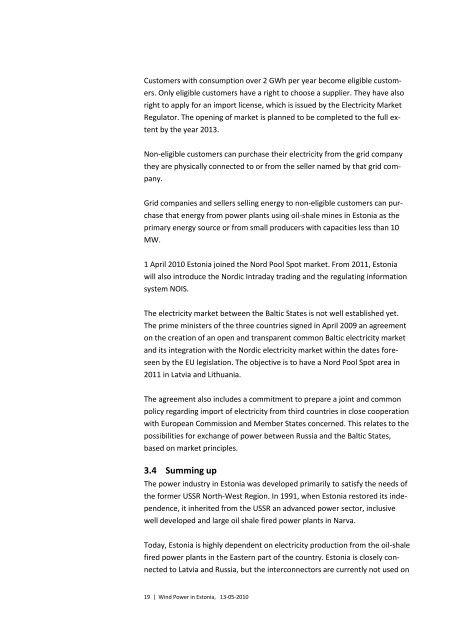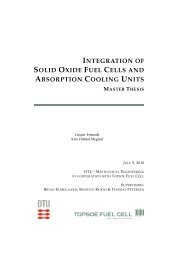Wind Power in Estonia - Elering
Wind Power in Estonia - Elering
Wind Power in Estonia - Elering
You also want an ePaper? Increase the reach of your titles
YUMPU automatically turns print PDFs into web optimized ePapers that Google loves.
Customers with consumption over 2 GWh per year become eligible customers.Only eligible customers have a right to choose a supplier. They have alsoright to apply for an import license, which is issued by the Electricity MarketRegulator. The open<strong>in</strong>g of market is planned to be completed to the full extentby the year 2013.Non-eligible customers can purchase their electricity from the grid companythey are physically connected to or from the seller named by that grid company.Grid companies and sellers sell<strong>in</strong>g energy to non-eligible customers can purchasethat energy from power plants us<strong>in</strong>g oil-shale m<strong>in</strong>es <strong>in</strong> <strong>Estonia</strong> as theprimary energy source or from small producers with capacities less than 10MW.1 April 2010 <strong>Estonia</strong> jo<strong>in</strong>ed the Nord Pool Spot market. From 2011, <strong>Estonia</strong>will also <strong>in</strong>troduce the Nordic Intraday trad<strong>in</strong>g and the regulat<strong>in</strong>g <strong>in</strong>formationsystem NOIS.The electricity market between the Baltic States is not well established yet.The prime m<strong>in</strong>isters of the three countries signed <strong>in</strong> April 2009 an agreementon the creation of an open and transparent common Baltic electricity marketand its <strong>in</strong>tegration with the Nordic electricity market with<strong>in</strong> the dates foreseenby the EU legislation. The objective is to have a Nord Pool Spot area <strong>in</strong>2011 <strong>in</strong> Latvia and Lithuania.The agreement also <strong>in</strong>cludes a commitment to prepare a jo<strong>in</strong>t and commonpolicy regard<strong>in</strong>g import of electricity from third countries <strong>in</strong> close cooperationwith European Commission and Member States concerned. This relates to thepossibilities for exchange of power between Russia and the Baltic States,based on market pr<strong>in</strong>ciples.3.4 Summ<strong>in</strong>g upThe power <strong>in</strong>dustry <strong>in</strong> <strong>Estonia</strong> was developed primarily to satisfy the needs ofthe former USSR North-West Region. In 1991, when <strong>Estonia</strong> restored its <strong>in</strong>dependence,it <strong>in</strong>herited from the USSR an advanced power sector, <strong>in</strong>clusivewell developed and large oil shale fired power plants <strong>in</strong> Narva.Today, <strong>Estonia</strong> is highly dependent on electricity production from the oil-shalefired power plants <strong>in</strong> the Eastern part of the country. <strong>Estonia</strong> is closely connectedto Latvia and Russia, but the <strong>in</strong>terconnectors are currently not used on19 | <strong>W<strong>in</strong>d</strong> <strong>Power</strong> <strong>in</strong> <strong>Estonia</strong>, 13-05-2010
















